Armored decked lightning. Cruiser II rank "Novik"
On the other hand, the design of the ship was very controversial, because the undoubted merits of the project were combined with very significant drawbacks, but perhaps this could have been avoided? The fighting in Port Arthur made Novik a famous and famous ship in Russia, but was its potential fully revealed? How wisely could the admirals manage the capabilities of this very specific ship? What success could he have achieved in battle? Was he used according to his tactical purpose, was he suitable for him? How justified was the construction of a series of such ships, considering the very different from the prototype Pearl and Emerald, as well as Boyarin, which was built according to a separate project? Did the fleet need small cruisers at all, and if so, was the Novik the optimal type of such a ship? In the cycle of articles offered to your attention, we will try to answer these and many other questions.
The history of the Novik armored cruiser can be counted from the Special Meeting held in November 1895, at which, perhaps, for the first time, the question was raised about the need for small reconnaissance cruisers with a displacement of 2-3 thousand tons intended for service in squadrons. But then a positive decision on this type of ships was not taken, and the question was “deferred” indefinitely.
However, they returned to him in 1897, when, during two meetings held on 12 and 27 in December, a radical strengthening of naval forces in the Far East was planned. Unfortunately, in 1895, the danger of strengthening the Imperial Japanese fleet has not yet been adequately assessed, but by 1897, the need to build a powerful Pacific fleet, even to the detriment of the Baltic Fleet, became quite obvious. It was clear that the Pacific Fleet needed to be built, but ... which one? The special meeting was to not only make a decision to strengthen our naval forces in the Far East, but also to determine the composition of the Pacific Squadron, that is, the number and types of warships to be built for Far Eastern needs.
In the intervals between the two meetings, some of the admirals participating in them expressed their views in writing. Perhaps the most conservative (if not to say mossy) were the views of Vice Admiral N.I. Kazakov, who believed that the Russian battleships were so good, and did not need to increase the speed and displacement, but did not say anything at all about the cruiser reconnaissance aircraft. Vice-Admiral I.M. Dikov in his note recommended to establish the proportion according to which one battleship of a squadron should account for one small reconnaissance cruiser and one destroyer.
Perhaps the most interesting and robust program presented by Vice-Admiral N.I. Skrydlov: in addition to three battleships of the Poltava and Peresvet type with Oslyabya, he proposed to build another battleship-cruiser of the Peresvet type and three large 15 000 armored ships. Thus, the squadron of the Pacific Ocean would receive nine battleships of three types, three units each, while the latter could have been created absolutely not inferior to those that Japan ordered for itself in England. To these impressive linear forces N.I. Skrydlov recommended adding the same number of reconnaissance cruisers (one for each battleship) with a displacement of 3 000 - 4 000 t.
But the most “ornate” structure was proposed by the future governor of His Imperial Majesty in the Far East, and at that time Vice-Admiral E.A. Alekseev, who proposed the formation of a squadron of eight battleships, eight armored cruisers, eight large armored cruisers in 5 000 - 6 000 t. Displacement and eight small reconnaissance cruisers, but not one, but two types. E.A. Alekseev proposed building four small cruisers for 3 000 - 3 500 and as many with a displacement of less than 1 500.
As we have said, the reconnaissance cruiser was a new type of warship, which had no analogues in the Russian Imperial Navy before. The squadron battleships, although they did not keep their lineage from the sailing battleships of gray times, performed the same function and task - defeating the main enemy forces in a linear battle. Domestic cruisers, as a class of ships, gradually grew out of frigates, corvettes and clippers, but here, in fact, everything is not easy. The evolution of frigates is the most understandable - the latter, having received first steam engines and iron hulls, then turned into armored cruisers.
But the development of corvettes and clippers went a more complicated way. At the time of the sailing fleet, the corvette was intended for reconnaissance and messenger service, and as such could have been considered the distant ancestor of the Novik, but the fact that with the advent of the steam era this class of ships in the domestic fleet evolved very quickly into a “thoroughbred” cruiser, there is a ship, the main task of which is the violation of enemy shipping. As for the clippers, their first screw representatives in the domestic fleet were generally intended for the defense of the White Sea in the north, and could be regarded more as a kind of high-speed version of a gunboat. However, a little later, it was considered necessary to charge the clippers with ocean cruising. And it turned out that Russia began to design and build corvettes and clippers as light ocean cruisers: accordingly, having similar tasks, the ships of these classes quickly became close in their tactical and technical characteristics. In essence, in the 1860's, the Russian clipper was a ship, about a quarter lighter than a corvette and with lighter weapons, but at the same time superior to a corvette in speed.
It is not surprising that the construction of two classes of ships for the Russian fleet, designed to solve practically the same tasks, could not be justified: sooner or later, corvettes and clippers had to either merge into one class, or receive different tasks justifying the existence of both classes. For some time, the first path prevailed: with the advent of the metal hulls, the construction of the corvettes stopped, only frigates and clippers were laid. We are talking, of course, about the Clippers of the “Cruiser” type - but alas, it would have been difficult to come up with a ship less suitable for use as a reconnaissance vehicle in a squadron than domestic clippers with a metal hull.
Having a small size (1 334 t) and, accordingly, cost, clippers of the type “Cruiser” were very slow moving, losing in speed even with much larger domestic armored frigates. Founded in 1873, the “Cruiser” under the steam engine was supposed to produce 12 units, while the armored “General-Admiral” and “Herzog Edinburgh”, which were started in 1869 and 1872, were to be built. accordingly, they calculated the speed in 14 nodes, although in fact, due to overload, it developed slightly more than 13 nodes. But the developed cruiser armament of the “Cruiser” was supposed to provide him speed under sail to 13 knots, which, of course, was not expected from armored frigates. High speed sailing, without a doubt, seriously increased the autonomy of the clippers, but did not help at all with the service during the squadron. Yes, strictly speaking, they didn’t need it, because at the time of the construction of the Cruisers, no squadron in which they could serve existed in nature. The Russian Empire, cramped in funds, then refused to build battleships, preferring a cruising strategy and focusing on armored frigates and clippers. Thus, “in the face of” Clippers of the “Cruiser” type, the domestic fleet received very specific ships specialized for operations on enemy communications, and in addition, capable of displaying a flag and representing the interests of Russia abroad. As for the corvettes, they were not built ... more precisely, not quite so, because the armored "General-Admiral" and "Herzog Edinburgh" armored corvettes were originally designed, but then they were enlisted in the "frigate" rank.
Years passed, and it became clear that the clipper concept no longer justifies itself, and that more rapid and powerful ships are needed for operations on oceanic communications. Those were the Vityaz and Rynda, the first armored cruisers of the Russian Empire, which were not very fast, but significantly larger (3 000), and better armed than the Cruiser.
Since the Vityaz and Rynda occupied an intermediate position between armored frigates and clippers, they were called corvettes during laying, so this class of ships was revived for a while in the Russian fleet only to give rise to armored cruisers. But the history of clippers in the domestic shipbuilding is over.
Thus, despite the presence in the Russian Imperial Navy of two classes of ships identical to the light cruiser, both corvettes and clippers were created primarily for ocean cruising, and could not be considered a prototype of a cruiser reconnaissance in a squadron, and the same, in general, It also refers to the first armored cruisers of the Russian fleet, the Vityaz and Rynde, and then came a long vacation in the construction of ships of this class. In the period from 1883 to 1896, only two such ships were ordered: the Admiral Kornilov and Svetlana armored cruisers. But the first of them continued the Vityaz development line in the direction of the ocean cruiser to fight on communications - it was a very large ship, whose normal displacement would be calculated to be 5 300 t
As for the "Svetlana", its dimensions were more modest (slightly more than 3 900 t normal displacement), but you need to understand that this ship was not the embodiment of the admirals' tactical views, but the whim of General Admiral Alexey Alexandrovitch, who was impressed (of a different word and you will not pick up) to have a personal yacht in the form of an armored cruiser, for which he selected a French prototype that suits him. In other words, the combat qualities of the Svetlana were relegated to the background, this cruiser did not fit into the concept of the national fleet and, accordingly, there could be no question of building a series of such ships in domestic shipyards - admirals of the Russian fleet seemed unnecessary.
The further development of armored cruisers led to the appearance of Pallas-type ships built at domestic shipyards in 1897. Here our naval thought swept aside (I must say, very unsuccessfully) to create a cruiser capable of both raiding the ocean and conducting reconnaissance and patrol service at the squadron. Naturally, for such versatility, we had to pay in size and in general, of course, the Pallas, Diana and Aurora did not at all resemble a specialized squadron cruiser scout.
It so happened that before 1897 (well, well, before 1895 g) a ship of this type was completely unnecessary, but then our admirals suddenly needed it in large quantities. What tasks did they set for this subclass of cruisers? E.A. Alekseev believed that such ships: “should serve in the squadron with forzeyly, reconnaissance, messenger cruisers to transfer important and urgent orders separately to the detachments or ships operating from the fleet” (forzeyl is an obsolete term for a high-speed ship going ahead of the squadron), and Ships less than 1 500 tons should also measure and reconnaissance at the coast and at the ports, which is why they needed a small draft.
Vice-Admiral I.M. Dikov considered speed to be the main quality of a scout cruiser. Such a ship, in his opinion, “can and must evade any battle, during reconnaissance, taking care not of small victories and combat differences of personnel, but of the execution of the assignment given to him ... ... From the experiments in the Black Sea, it can be concluded that the results the intelligence services are proportional not to the speeds, but almost to the squares of the speeds of the intelligence officers. ”
It seems to be a rather strange picture - almost all vice-admirals spoke in favor of building small reconnaissance cruisers, narrowly specialized for service in a squadron in an enormous number (one for each battleship), and yet two years ago the question of their construction was "Safely" launched on the brakes. One can try to explain this paradox by the fact that by the 1897 in the Baltic the fleet had received an armored squadron from relatively modern ships and already had some experience of their joint actions. We are talking about two "battleships-ram" type "Emperor Alexander II", as well as "Sisoe Veliky" and "Navarino", of which the first three at the end of 1896 - the beginning of 1897. together with the mine-cruisers and destroyers attached to them, they formed the Mediterranean squadron. The latter even had to take part in the “operation close to combat” - the blockade of Fr. Crete, announced 6 March 1897 g (old style). And it can be assumed that the practice of driving an armored squadron showed the extreme need for specialized cruisers for the squadron service. After all, creating the newest battleships, the Russian Empire did not care at all about the ships “serving” them, and those that were part of the fleet were not suitable for such work. Armored cruisers were large ocean raiders, remaining clippers were too slow-moving (even slower than battleships), mine-cruisers did not have enough speed and seaworthiness, and the destroyers, although they had sufficient speed (ships of the Falcon type developed 26,5 ties), but had too low displacement and, as a result, quickly lost this speed during agitation, while not having sufficient autonomy.
During the Special Meeting, the General-Admiral, who, apparently, was somewhat shocked by the admirals' demand to build such a number of reconnaissance cruisers, suggested abandoning them, and using the saved funds to strengthen the Pacific Squadron with one or even a pair of newest battleships. But the rest of the admirals chose to reject the proposal, pointing out that now, in the absence of other ships, the service in the squadron has to be assigned to gunners of the Korean and Thundery types, which were completely unsuitable for this role. It can be assumed that in spite of the fact that the gunboats were never intended for squadron service at all, other ships of the national navy were even less suitable for it.
True, in the Black Sea, a similar connection existed from 1899, when the first three battleships of the Catherine II type entered service, and, in theory, the need for reconnaissance cruisers should have been revealed long ago. What prevented this - it is difficult to say: it was possible that the Black Sea armadillos were considered primarily as a means of capturing the Bosporus and the encounter in it with the ships of the European powers, if the latter defend Turkey. Possibly, the remoteness of the Black Sea theater from St. Petersburg affected, by virtue of which the latter was not as “in sight” as the Baltic theater, and its problems were heeded less. But in any case, it should be noted that Vice-Admiral I.M. Dikov, in his note, referred to some "experiments in the Black Sea," irrefutably indicating the need for small, high-speed cruisers as part of an armored squadron. Unfortunately, the author of this article was unable to find out what these "experiments" were, but it is obvious that the Black Sea squadron, which by the end of 1897 had already consisted of six battleships (four types of "Catherine II", "Twelve Apostles" and "Three saints"), also felt a great need for ships of this type.
The special meeting determined the squadron of the Pacific in 10 squadron battleships (counting the construction of three ships of the Sevastopol type and two types of Peresvet), four armored cruisers, 10 X-ray armored cruisers of the 1-rank and 10 armored cruisers of the 2 cruisers-XIHXX cruisers of the 2-X cruise cruisers of the 36-grade and 11 armored cruisers of the 1898 cruisers of the 2 XNUMX cruisers of the XNUMX-X cruise cruisers of the XNUMX X-grade cruisers and XNUMX of the XNUMX X-ray cruisers of the XNUMX-X cruise cruisers. scouts cruisers. In addition, it was also planned to bring the total number of mine forces in the Far East to XNUMX minelayers, XNUMX "fighters" and XNUMX destroyers. Subsequently, however, by the Special Meeting of XNUMX, this composition underwent some changes - one armored cruiser was added, and X-NUMX-grade armored cruisers were reduced to six. Despite all this, the shipbuilding program for the needs of the Far East should be recognized as quite timely and adequate - but alas, its adoption was marked by events that largely predetermined the outcome of the Russo-Japanese war.
The fact is that such naval construction, of course, was very costly and required the order of 200 million rubles. The Navy wanted to get this money before 1903, because its specialists were absolutely able to predict the year when Japan would complete its rearmament at sea and would be ready to go to war. That is exactly what happened in reality. However, the domestic Ministry of Finance, represented by its head S.Yu. Witte resisted this, deciding from something that Japan would not be able to arm until 1905. Therefore, the Minister of Finance proposed stretching the financing of the program to 1905, and moreover, reducing it by no less than 50 millions. The maritime agency with such proposals was categorically disagreed, as a result of which 20 February 1898 was held a meeting chaired by the king. A compromise was made on it - to keep financing in the amount of 200 million rubles, but to stretch it to 1905. As a result, the Russian Empire did not have time to concentrate the necessary forces in the Far East before the beginning of the war in January 1904. Who knows how to turn are you doing if by the winter of 1903 the squadron of Port Arthur numbered not 7, but 10 battleships? "The great distance" in Port Arthur justified inexpedient to give general battle 5 remaining battleships and "Bayan" squadron H. Togo, which, even after the separation from her four armored cruisers Kamimura numbered 6 2 large battleships and armored cruisers (who was joined by "Nisshin "and" Kasuga ", but what if at the beginning of the war the Russians, even with the failure of Retvizan and Tsesarevich, would have eight battleships left on the move? The statistics of the 27 January battle 1904 of Port Arthur is incontrovertible It says that at the beginning of the war, the Japanese were not at all so superior to the Russian commanders exactly that it would guarantee them victory ... And after arriving at the theater of S.O. Makarov with such a balance of forces, the general battle would have been predetermined.
But back to the scout cruisers.
Having decided to build the latter, it was necessary to determine the tactical and technical characteristics of the ships. Strangely enough, there were no disagreements among the admirals, and in March 1898 of the Marine Technical Committee (MTC) formulated the following tactical and technical elements (TTE) of the future cruiser:
Normal displacement - 3 000 t with coal stock 360 t .;
Speed - 25 knots .;
Travel range - 5 000 miles at economic speeds 10 knots .;
Armament - 6 * 120-mm, 6 * 47-mm, one amphibious 63,5-mm Baranovsky gun, 6 torpedo tubes with 12 torpedoes, 25 min obstacles;
Reservations - the deck of the greatest thickness, which is possible to obtain without prejudice to the above characteristics.
These characteristics suited everyone ... well, almost everyone. Vice Admiral S.O. Makarov, as we know, promoted the idea of a “vesselless vessel”, which, with a similar displacement, would have completely different qualities. For the first time, Stepan Osipovich voiced the idea of his cruiser in Chief, in 1895, and remained its supporter until his death.
The “no-fighter vessel”, according to S. O. Makarov, was supposed to be an armored, very heavily armed (2 * 203-mm, 4 * 152-mm, 12 * 75-mm guns) cruiser of very moderate speed (20 knots.) and displacement (3 000 t), but a sufficiently long cruising range - up to 6 000 miles.
The numbers indicate the tools: 1 - 152-mm, 2 - 75-mm, 3 - 203-mm. Armament differs in number from that indicated in the text, since the diagram does not depict the initial version of the “non-battle ship”, but the project of restructuring the Emerald and Pearl cruisers into such cruisers.
Usually sources indicate that Stepan Osipovich, without rejecting the need for long-distance reconnaissance, believed that high speed for the ships carrying it out was not mandatory, and explained this by the fact that the situation would constantly change, and the data of such reconnaissance would in any case be outdated . This is not entirely true, because S.O. Makarov recognized the importance of speed in reconnaissance, but did not see the point in building a large number of reconnaissance ships whose combat qualities were sacrificed for speed. In his essay “Armadillos or Armless Vessels?” He wrote:
As you know, S.O. Makarov believed that his "direct ships" not only can fight together with the armadillos, but even are able to replace them.
On the whole, of course, the vice admiral's opinion seemed too unusual and could not be accepted (much later Stepan Osipovich still “pushed” the construction of one such ship, but these plans were immediately canceled after his death). We are not going to give an assessment to the proposal of Sergei Makarov, and we will return to it at the final stage of this series of articles, when we analyze the actions and capabilities of Novik and the high-speed domestic cruisers of the 2 rank that followed. Now we are just stating that when developing the technical specifications for designing reconnaissance cruisers, the opinion of Stepan Osipovich was ignored.
It must be said that two design tasks were developed: the first of them contained the TTEs for the three-ton 25 hub ship mentioned above, and the second one suggested bringing the cruiser speed to ... 30 knots. Unfortunately, some detailed TTX of the “30-nodal” cruiser have not yet been found, but it can be assumed that the companies themselves were asked to determine the reduction in the TTX of the “25-nodal” cruiser, which would be required to ensure speed in 30 nodes.
The exact date of the announcement of the competition for the design of the future Novik, unfortunately, is unknown to the author, presumably - the first of April 1898. And the Navy Department received the first response already on April 10 - the German firm Hovaldsverke from Kiel sent their proposals.
Продолжение следует ...
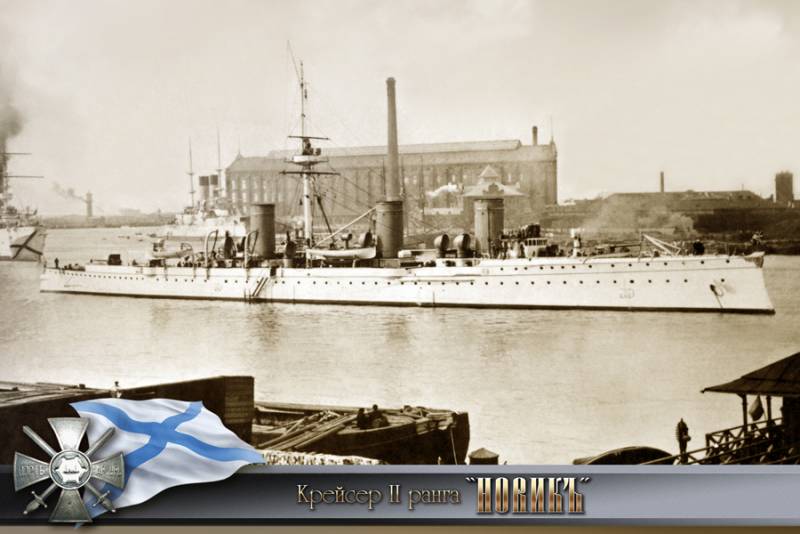
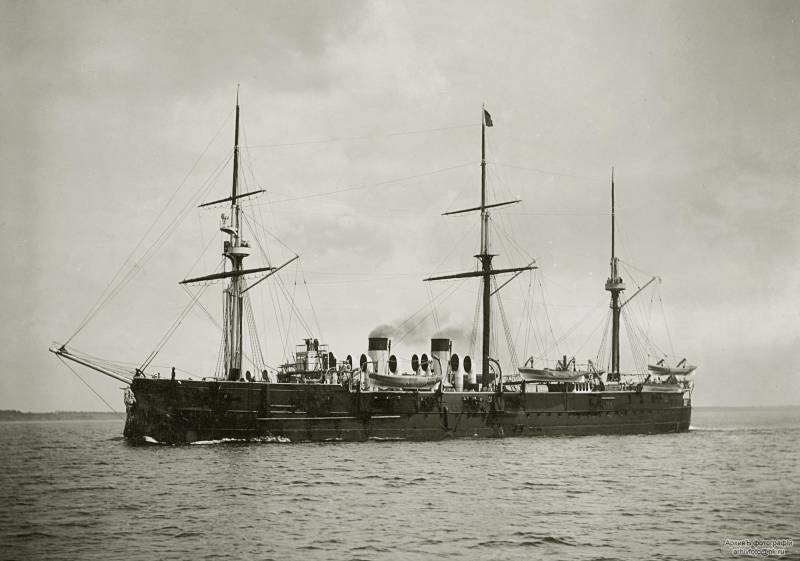
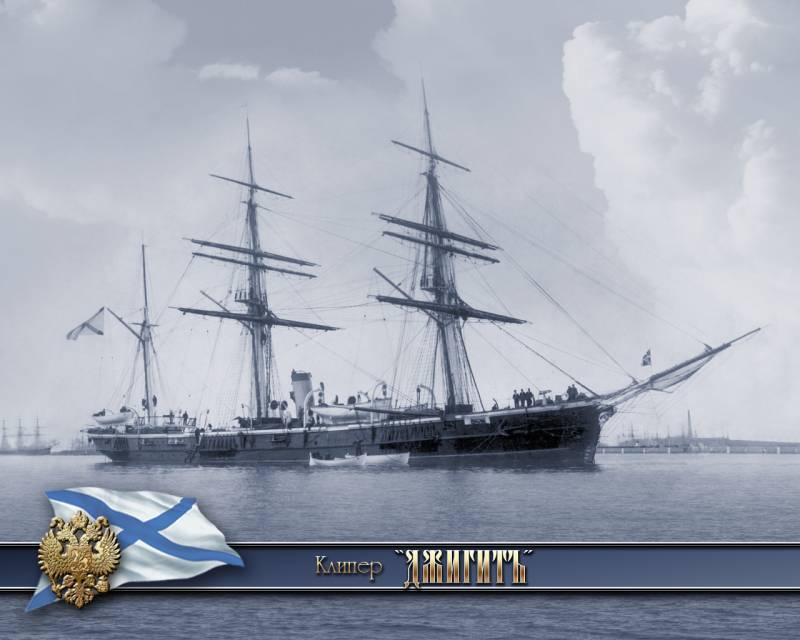
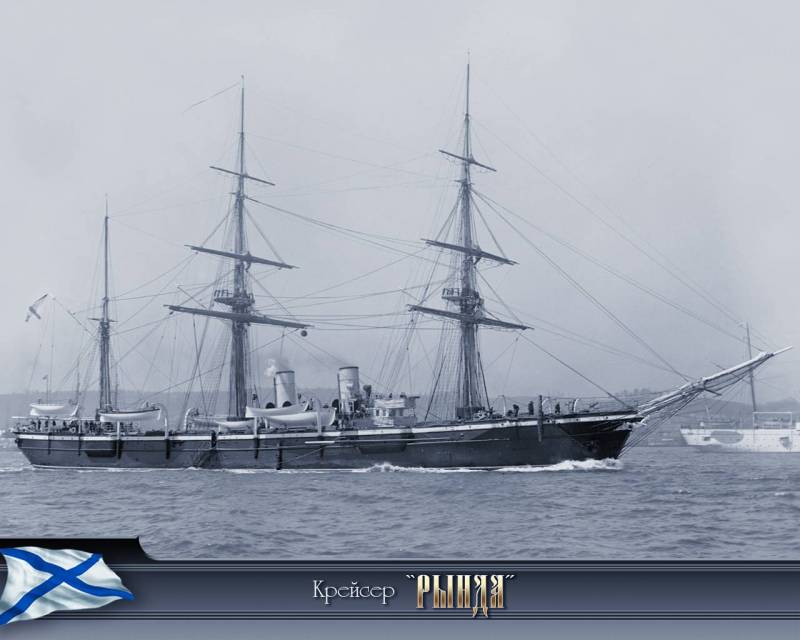
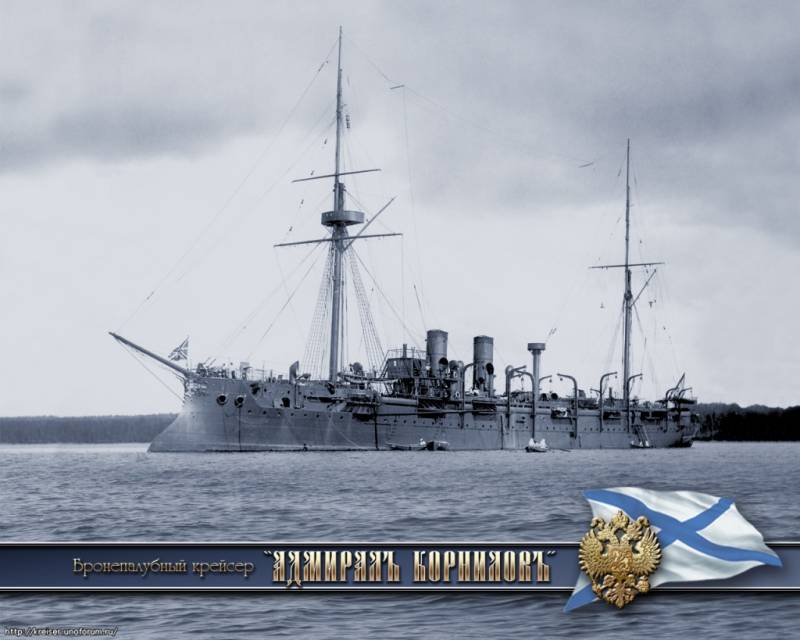
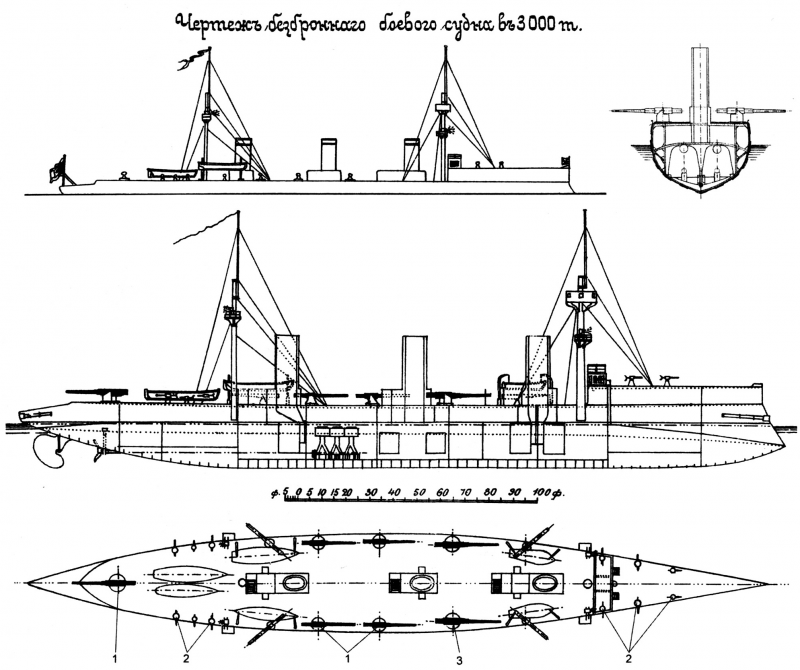
Information